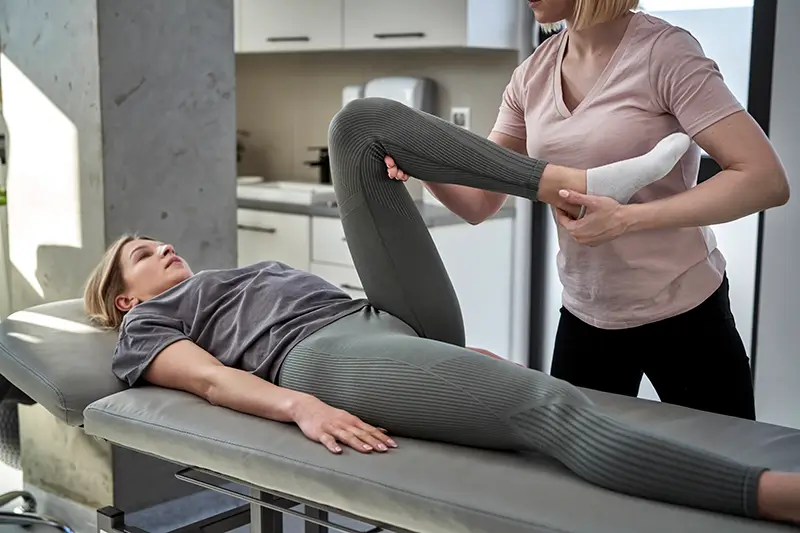Pelvic floor dysfunction refers to a condition where the muscles, ligaments, and connective tissues that support the pelvic organs become weak, tight, or impaired in some way. This leads to problems with pelvic floor function. Pelvic muscle rehabilitation (PMR) is a non-invasive and conservative approach to manage pelvic floor dysfunction. Understanding the coding terminology and guidelines specific to pelvic rehabilitation is essential for accurate documentation and billing. Healthcare professionals can rely on guidance and support from medical coding outsourcing specialists to report pelvic rehabilitation correctly, leading to improved patient outcomes and reimbursement.

Looking to optimize your medical coding?
Let us handle it for you!
Get started with our medical coding outsourcing services
Call (800) 670-2809
Pelvic Floor Dysfunction
Pelvic floor dysfunction refers to the inability to properly relax and coordinate the pelvic floor muscles during bowel movements. Common symptoms include constipation, straining while defecating, urinary or fecal leakage, and frequent urination. The condition affects more women than men. Up to 25 million adult Americans suffer from some form of urinary incontinence, and 75-80% of them are women.
Stress incontinence is due to inadequate urethral pressure; the patient loses urine during sneezing or other exertion. Urge incontinence is the involuntary loss of urine due to abnormal bladder contractions. Treatments include behavior therapy, medication, nerve stimulation, electrical and magnetic simulation and surgery. Many candidates for biofeedback have already had surgery.
Before resorting to surgical treatments for stress urinary incontinence (SUI), many urogynecologists try nonsurgical methods to treat the condition. Pelvic rehabilitation is the initial treatment option.
Coding Pelvic Rehabilitation
Pelvic rehabilitation is a multidisciplinary program typically involves biofeedback, pelvic floor physical therapy, electrical stimulation of the pelvic floor and functionally associated musculature, and medications. Pelvic floor muscle rehabilitation (PFMR) services offer a non-invasive and painless treatment option for a variety of bladder issues. With a 70-80 percent success rate, this approach significantly improves symptoms with minimal or no side effects. PFMR involves re-educating and toning the pelvic floor muscles, leading to positive effects on overall bladder function.
Although these options can billed and documented, payers may have certain limitations concerning the frequency of care and the eligible healthcare providers by whom the care may be rendered. Urologists and urogynecologists should know how to code these procedures as well as payer guidelines on coverage.
-
- Biofeedback Therapy
CPT codes 90901 and CPT 90911 are the two codes primarily used to code for biofeedback therapy.
CPT Code 90901 is a non-specific code that represents any modality of biofeedback therapy, such as thermal sensing, Electromyography (EMG), Neurofeedback or electroencephalography (EEG), or any other modality. Biofeedback training involves the duration during which the biofeedback modality remains attached to the patient, with the feedback results being utilized or examined by the patient or the clinician, or both. It is important to note that consecutively applied biofeedback modalities should not be charged separately. Therapists have the option to deliver a combination of biofeedback therapy and therapeutic exercises within the same 15-minute session to address specific patient needs. In such instances, the exercises are considered part of the biofeedback training and should not be billed independently. The appropriate biofeedback treatment code should be used for billing when providing combined services.
CPT code 90911 is used to bill for Pelvic Floor Therapy training for addressing incontinence issues. Code 90911 is used for targeted biofeedback training that focuses on the perineal muscles, anorectal or urethral sphincter, and may involve EMG and/or manometry.
An AAPC article provides the following example that the American Urological Association (AUA) and APTA recommend for reporting PFMR:
CPT code 90911 Biofeedback training, perineal muscles, anorectal or urethral sphincter, including EMG and/or manometry ), 97032 ( Application of a modality to 1 or more areas; electrical stimulation [manual], each 15 minutes ), and 91122 ( Anorectal manometry)
CPT code 51784 ( Electromyography studies (EMG) of anal or urethral sphincter, other than needle, any technique ) at the initial and final visits to assess the patient’s response.
The article also points out that code 91122 represents a study that is done to assess the patient with fecal incontinence, not urinary stress incontinence. Documenting the condition in the record is necessary to bill this study.
-
- Electrical Stimulation
CMS covers sacral nerve stimulation is covered for the treatment of urinary urge incontinence, urgency-frequency syndrome, and urinary retention. Sacral nerve stimulation involves both a temporary test stimulation to determine if an implantable stimulator would be effective and a permanent implantation in appropriate candidates. Both the test and the permanent implantation are covered(CMS National Coverage Determination (NCD) 230.18, http://www.cms.gov/Regulations-and-Guidance/Guidance/Manuals/Downloads/ncd103c1_Part4.pdf.).
64561 Percutaneous implantation of neurostimulator electrode array; sacral nerve (transforaminal placement) including image guidance, if performed
64581 Open implantation of neurostimulator electrode array; sacral nerve (transforaminal placement)
Ancillary codes:
64585Revision or removal of peripheral neurostimulator electrode array
64590Insertion or replacement of peripheral or gastric neurostimulator pulse generator or receiver, direct or inductive coupling
64595Revision or removal of peripheral or gastric neurostimulator pulse generator or receiver
A4290 Sacral nerve stimulation test lead, each
C1767Generator, neurostimulator (implantable), non-rechargeable
C1778Lead, neurostimulator (implantable)
C1820Generator, neurostimulator (implantable), with rechargeable battery and charging system
C1883Adapter/extension, pacing lead or neurostimulator lead (implantable)
C1897 Lead, neurostimulator test kit (implantable)
l8680Implantable neurostimulator electrode, each
Reporting Pelvic Floor Therapy – Points to Note
Medicare allows coverage for the probe for pelvic floor therapy while some carriers cover the therapy itself. Here are some key points to note when reporting this service:
- Coverage of biofeedback therapy services varies from payer to payer
- Many payers limit the coverage of biofeedback therapy services to specific conditions and diagnoses.
- The Centers for Medicare and Medicaid Services (CMS) has issued National Coverage Determination (NCD) guidance titled “Biofeedback Therapy for the Treatment of Urinary Incontinence (30.1.1). The guidance notes that biofeedback-assisted pelvic muscle exercise training incorporates the use of an electronic or mechanical device to convey feedback (visual and / or auditory) regarding the muscle tone of a patient’s pelvic floor.
- Medicare will only cover biofeedback for the treatment of stress and urge incontinence in cognitively intact patients when the medical documentation shows that a trial of pelvic muscle exercise training was previously tried and failed.
- Kegel exercises help to strengthen the pelvic floor muscle and improve bladder control. Virtually all payers require that the patient perform the first primary treatment for urinary incontinence at home. Medicare pays for Kegel exercises with biofeedback, but not for Kegel exercises (which are done by the patient at home) alone.
- Usually six to eight sessions of pelvic floor muscle rehabilitation (PFMR) services are payable by Medicare and other non-Medicare payers
Tips for Reporting Pelvic Rehabilitation
- Supervise therapy training services: Medicare billable therapy services may be provided by any of the following within their scope of practice and consistent with state and local law: Physician; Non-physician practitioner (NPP) (physician assistants, nurse practitioners, clinical nurse specialists); Qualified physical and occupational therapists, speech language pathologists (for CPT codes G0515 and 97533), and assistants working under the supervision of a qualified therapist; Qualified personnel, with or without a license to practice therapy, who have been educated and trained as therapists and qualify to furnish therapy services only under direct supervision incident to a physician or NPP(LCD 33631).
- Ensure complete and proper documentation: Document the services provided. Inadequate and improper documentation of services rendered is one of the
most frequent reasons for claim denial on the grounds of “services billed not medically necessary”. For office visits that involve the management of pain medications, it is important that documentation for each encounter clearly defines the progress the patient is making in setting goals for pain management. Complete documentation is necessary to support the medical necessity of each visit at the level billed.
- Justify the therapy: It is necessary to provide evidence and documentation that pelvic muscle exercise training failed when billing code 90911. Denials for claims with CPT Code 90911 occur when there is insufficient evidence of the patient undergoing a four-week course of unsuccessful pelvic muscle exercise training before attempting pelvic floor therapy, and when this therapy did not resolve their incontinence problems. Frequent audits of CPT Code 90911 have revealed instances where the necessary prerequisite exercise training was not properly conducted. Diagnoses that support PFMR may include:
- N39.3 Stress incontinence (female) (male) Code also any associated overactive bladder (N32.81) Excludes1: mixed incontinence (N39.46)
- R39. 81 Functional urinary incontinence
- N81.84 Pelvic Muscle Wasting
- R35.0 Urinary frequency
- N39.41 Urge incontinence (Excludes1: mixed incontinence (N39.46))
- R35.1 Nocturia
- Exercise caution when using Modifier 25: Modifier 25 is used to indicate that a patient’s condition required a significant, separately identifiable evaluation and management (E/M) service above and beyond that associated with another procedure or service being reported by the same physician or other qualified health care professional (QHP) on the same date. Billing the Medicare program for a significant, separately identifiable E/M service provided by the same physician on the same day as lavage and / or pelvic floor therapy services will come under auditor scrutiny.
- Perform reviews to identify risks: Urogynecology and OB/GYN practices should perform a review of their own to identify and address any regulatory risks that may be present in their organizational setting, recommends www.lilesparker.com. A baseline audit can identify problems that need correction and potential risk areas, so that they can be dealt with.
Accurately coding and billing rehabilitation services can be challenging due to the need to use specific and sometimes intricate codes. Different insurance companies may have varying coverage policies for pelvic rehabilitation, leading to confusion and additional administrative burden for billing staff. Claims for Pelvic Rehabilitation services may be denied for various reasons, such as coding errors, lack of medical necessity, or missing information. Handling claim denials and the appeals process can be a tedious and resource-intensive task.
The support of an experienced medical billing company can go a long way to ensure a smooth billing process. Experts stay up-to-date with coding guidelines, documentation requirements, and insurance policies, and can help providers minimize claim denials and maximize revenue.

Streamline your medical billing processes and boost practice efficiency!




